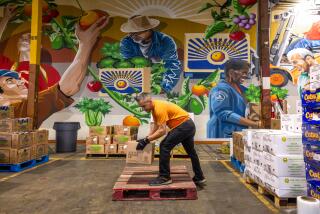MARKET FORCE
It’s 8 a.m., an hour before the Wednesday Santa Monica farmers market opens. As the last of 90 trucks backs beeping into its space, an anticipatory hum arises.
It grows as farmers click open canopies, set up tables and display their dazzling cornucopia: zebra-striped and red ruffled heirloom tomatoes; purple Peruvian potatoes; fancy white asparagus and haricots verts; blushing apricots and juice-spurtingly ripe peaches.
By market rules, no one can buy until 9 a.m., but by 8:30, early birds have reserved the rarities, such as passion fruit and ripe sapotes at Coleman Family Farms and tiny, intensely perfumed Charentais melons at Lahr’s Greenhouses. As the minutes tick by, impatient shoppers ask, “Is it 9 yet?”
Then the horn sounds and the weekly rhythm of the market shifts into overdrive. Vendors offer sample cherries and strawberries, mothers push strollers, chefs wheel handcarts, tourists gawk and chador-clad Middle Eastern women gossip among themselves. On sunny mornings, bundle-bearing foragers overflow Arizona Avenue.
In Los Angeles, Orange and Ventura counties, there are 79 certified farmers markets, about twice as many as a decade ago. From Santa Clarita to San Clemente, each market--large and small, day and evening--has a distinctive personality, blending farmers, location and community. It’s easy to take these markets for granted, but the first in the Southland, Gardena, started just 20 years ago.
They have revolutionized the growing and selling of produce. When farmers sell to wholesalers, they must raise large lots of productive, attractive varieties that ship and store well. Flavor is secondary, because growers generally receive no premium for good taste.
At farmers markets, on the other hand, buyers can sample and choose the tastiest nectarines or tomatoes and return to their favorite stands.
This dynamic has enabled countless farmers who would otherwise have succumbed to consolidation or suburbanization to earn a living by growing small quantities, emphasizing high quality, neglected varieties and specialty crops.
Farmers set their own prices and receive immediate cash payment. For consumers, farmers markets mean fresher and riper produce and often lower prices.
Just as important, market-goers can meet friends, schmooze with growers and ask questions like, “What’s this?” “How do you cook it?” and “When does your corn come in?”
Actually, this revolution is nothing new. In California’s early years, there were markets at which farmers sold directly to consumers. By the mid-20th century, however, industry-sponsored requirements for uniform sizing, packing and labeling of produce, along with suburbanization and supermarkets, forced the markets to close or shift to conventional retailing (as did the famous Farmers Market at Third Street and Fairfax Avenue in Los Angeles).
In the mid-1970s, farmers, consumers and community activists protested laws hindering direct sales, but grocery interests resisted. The breakthrough came after a bumper crop of stone fruit and a cannery strike in 1976 brought ruinously low prices for farmers.
On April 29, 1977, at the urging of Gov. Edmund Brown Jr., the California Department of Food and Agriculture adopted regulations allowing certification of farmers and farmers markets and exempting participants from commercial packing requirements. Soon afterward, markets at San Francisco’s Alemany market and at Davis, which had operated informally, became certified.
To ensure that the fruits, nuts, vegetables, eggs, flowers and plants at farmers markets come direct from the farmer, the agricultural commissioner of each California county certifies growers and markets. Only certified producers can sell at certified markets, and they can offer only items, listed on a certificate, that an inspector verifies have been grown by them (though they can also, to a limited extent, sell the produce of other certified growers).
The Interfaith Hunger Coalition, a group of religious and community leaders who sought to improve low-income residents’ access to food, organized the first successful certified farmers markets in the Southland.
The Gardena market opened June 23, 1979, in a church parking lot. “The reception was tremendous,” says Vance Corum, who organized the market. “We had four stands, representing five farmers. They sold $1,628, everything they had. We had to beg latecomers to come back the next week.” The market still flourishes and draws a lively crowd.
Pacoima (since closed), Pasadena Villa Park, Long Beach Downtown and the market at Adams and Vermont in L.A. followed in 1980. The first Orange County markets, Costa Mesa and Fullerton’s Wednesday operation, started the next year.
Today, more than 4,000 growers attend 350 farmers markets statewide. Les Portello, an economist for the food and agriculture department, estimates that excluding flowers and plants, the markets sell $150 million of produce annually, roughly 1% of what the state’s farmers earn on those crops.
A drop in the bucket, perhaps, but the markets’ importance transcends economics. Besides keeping small farms in business, they inspire chefs, motivate supermarkets to upgrade the quality and ripeness of their produce and provide a testing ground for new varieties.
For instance, when Gregory Partida, a professor at Cal Poly Pomona, sells fruits from the university’s orchards at the West Covina market, feedback from the stand helps him assess the commercial potential of experimental low-chill stone fruits and exotic citrus.
Not only small farms participate. For example, Logoluso Family Farms, which grows thousands of acres of fruit in the Central Valley, started selling at five farmers markets three weeks ago, seeking additional income from direct sales.
The family found that the learning curve can be steep for a big grower adjusting from the world of commercial shipping. At the Whittier market, a crowd gathered to buy Logoluso’s Tulare cherries at $2.50 a pound, cheaper than at neighboring stalls. The cherries tasted pretty good, but the stand’s Queencrest peaches looked a bit greenish, felt hard and bore stickers, supermarket style. On the other hand, the Logolusos also grow superb Pink Lady apples that they sell in the fall.
Down the street, Truman Kennedy sold fresh and dried fruit from his 52-acre farm in Reedley. Epitomizing the best of the growers, he specializes in unusual and heirloom stone fruits, among others ultra-rare red apricots, scarlet all the way through like beets; luscious, fragile white Nectar peaches; and Stanwick nectarines, intense, tangy and incredibly sweet, with a hint of pineapple.
A retired school principal, amiable and bearlike, Kennedy is always ready with a folksy joke. Closing a sale, he makes change in apricots, saying, “You have a delicious day!”
Some markets offer backyard growers, a special treat. At Whittier, Bud Hirayama displayed carrots, salad mix, mint and arugula from his quarter-acre Anaheim backyard. “It’s like a jungle in there,” he said with a chuckle.
That’s big agriculture to Jim Bernabe of Norwalk, whose certificate lists only one tree, a Fuyu persimmon. Why does he bother? “Good Lord, why should I waste these persimmons?” he asks. “Otherwise they’ll fall on the ground and rot.”
Many markets also carry nonagricultural items that don’t require farm certificates: bread, fish and prepared foods such as hot sauces, tamales and hot dogs. Vendors of these items are supposed to be segregated in “nonag” areas, demarcated by signs or traffic cones, but the distinction is not always discernible.
At a dozen or so markets--mostly newer ones held in the evening--produce is just part of a larger festival. In San Dimas, crafts booths, live country music, a Ferris wheel and pony rides foster a carnival atmosphere amid Western-theme buildings. Purists sniff that such diversions dilute the markets’ original purpose, but Harry Brown-Hiegel, manager of San Dimas and three similar markets, maintains that the festival format best serves the needs of communities today.
They use what he calls multidimensional markets to draw visitors and revenue to their downtown streets. Moreover, some of the markets probably couldn’t survive without the fees from non-produce booths.
For farmers markets, nothing succeeds like success: Customers won’t come unless there’s a good selection, but farmers won’t participate until there’s enough traffic to make money.
Market managers balance bringing in new growers to provide diversity against the risk of alienating established vendors. There’s a waiting list to sell at big markets such as Santa Monica and Hollywood, but often small markets struggle to attract growers and even fold.
Although new markets delight local consumers, the result is that farmers find themselves stretched thin and have to hire employees to run their stands.
When demand for produce exceeds supply, a few unscrupulous vendors try to supplement their own crops. In one egregious case, an agricultural inspector caught a farmer buying Washington state apples at the Los Angeles wholesale produce market. To guard against such fraud, county and state inspectors have recently tightened.
Over the years, Mort Bernstein, manager of the Santa Monica organic market, has kicked out several sellers for cheating. “It not only affects quality, it devastates the morale of honest growers,” he said at his market last Saturday. “They’re digging and sweating while the other guys just peddle.”
When market-goers buy directly from farmers who grow what they sell, they understand where food comes from. “This is not a supermarket where everything’s available all the time,” said Bernstein. “When customers look farmers in the eyes and see their labors in their hands, they appreciate the seasonality of crops. They gain respect for the farmers and their land.”
More to Read
Eat your way across L.A.
Get our weekly Tasting Notes newsletter for reviews, news and more.
You may occasionally receive promotional content from the Los Angeles Times.










